Organisations operate in a continuously changing environment where they are exposed to financial and reputational damage if legal concerns arise. As a result, there is an increasing expectation that in-house legal teams or office compliance staff would take greater responsibility to identify, manage, and reduce legal risks within their businesses.
Conformity to legal requirements entails not only knowing and comprehending the legislation that relates to the business or organisation but also being able to demonstrate evidence that the business and its entities are always in compliance.
What is legal register?
Legal compliance is the method by which an organization abides by the complex environment, health & safety (EHS) laws, procedures, and processes that govern business practices in a specific country. While a Legal Register is a database of laws that an organisation is required to comply with as a result of its activity. The legal register can be electronic, excel or paper-based format, and may contain specific laws of a certain type, such as environmental or occupational health and safety regulations, or it may contain legislation of all types.

The organisational structure needed to ensure adequate management of legal risk will depend on various factors, including the industry, sector, and jurisdiction in which your business operates. Maintaining records of checks, having rules and processes in place around the legislation, and retaining evidence that the appropriate individuals are taking responsibility for compliance are all part of the compliance process.
Steps to evaluating legal compliance
The organisational structure needed to ensure adequate management of legal risk will depend on various factors, including the industry, sector, and jurisdiction in which your business operates. Maintaining records of checks, having rules and processes in place around the legislation, and retaining evidence that the appropriate individuals are taking responsibility for compliance are all part of the compliance process.
1. Identify
There are a number of ways to help identify legal risks that might have a significant impact on an organisation’s business plan or objectives. The first is to make sure that risks are properly recognized by identifying the appropriate EHS legislation, regulations, directives, and standards applicable to your organisation.
2. Requirements
Create a list of your legal requirements and cite applicable laws, regulations, directives, and standards relevant to your organisation and systematically document them in a centralized database system.
3. Assess the risks
Build a framework and methodology to assess risks and set rules and policies that will describe how your organisation can follow compliance standards. Include pieces of evidence that will demonstrate your compliance.
4. Applicability
As the applicable legal provisions change regularly, a good EHS legal register is kept up to date daily, based on an assessment of how the operational activities and other aspects of each business unit/site of the organisation have changed.
5. Monitor changes
Monitor changes that may impact your organisation. Notifications of regulatory changes in the applicable legal provisions and requirements should be communicated to the personnel within the organisation who are tasked to maintain the EHS legal register record.
Key takeaway
Management of compliance policies and documents will always be a key responsibility. To implement a good internal compliance system, organisations can rely on their in-house legal team or compliance office staff to develop and manage compliance. Organisations that lack resources or knowledge on legal compliance can engage EHS experts who are capable of designing a compliance program to assure they can keep up with the ever-changing regulatory environment.
ESC helps businesses to assess and build the EHS Legal Register and provide regular updates to help you comply with the regulations in your region. Our deep knowledge of the local regulatory structures and established professional relationship with regulatory authorities, enable our clients to have an easy understanding of the laws and regulations that apply to their business.

